click here for a larger view
I was fortunate to be given an opportunity to review the DVD version of La polvere di Morandi/ Morandi’s Dust
produced by Imago Orbis and Written and directed by Mario Chemello. More information and trailers can be viewed from their website
The DVD can be purchased at this link: http://www.imagoorbis.it/store (regretfully they are out of stock currently)
It is refreshing to watch a documentary about a painter where the focus is centered on the painting. Art instead of drama. Rather than stories of scandal and intrigue we get the slow and quiet poetics of a painter at his craft. Not much happens in Morandi’s modest home in Bologna where he lived with his mother and three sisters for most of his life. Not much except his making many of the 20th century’s greatest paintings. Morandi once said: “From a very early age, I showed a great passion for painting, a passion which grew stronger as the years passed, to the extent that I felt the need to devote myself entirely to it.”
This film has the kind of thrills only a painter is likely to appreciate, such as the slowly opening and closing of a studio shutter to let light fall across a still life. Watching the wind blow through the fields outside Morandi’s Grizzana studio, showing the view out Morandi’s window where he would have pointed his monocular lens to select and paint views from the surrounding landscape. Or perhaps seeing the varied cross-hatching of his closely studied Rembrandt etchings.
The Director and writer, Mario Chemello keeps the most of the film’s focus on Morandi’s art but we do get brief glimpses into his personal life. For instance we’re told by a neighbor that Morandi liked to keep chestnut conkers in his pocket for good health or how he designed his second home in Grizzana with simple child-like drawing. However, we don’t learn much about his sisters, who he lived with his whole life. Questions like who he was he close to or why he never married were not asked. We also don’t learn much about about his early years as a painter or his teaching of printmaking. But as this allows us more time to spend with the art, I wasn’t disappointed.
The film is given the title, “Giorgio Morandi Dust: Three Houses” The three houses refer to his first home (in Bologna) his second home in nearby Grizzana (which he had built late in his life after his studio window was blocked by construction) The third home refers to his more abstract, virtual home in painting itself. The film has many fascinating interviews with various people who knew him such as Laura Mattioli, daughter of an art collector friend of Morandi, who talks about the excessive dust in Morandi’s studio. The dust is a recurring and important element of the film as well as a central character in Morandi’s painting. The dust acts as a unifying force, covering everything with the same muted patina. It has a dual purpose of accentuating what is similar as well as the orchestration of nuanced differences.
As the art historian John Rewald on his visit to Morandi’s studio in 1964 said:
‘No skylight, no vast expanses; an ordinary room of a middle class apartment lit by two ordinary windows. But the rest was extraordinary: on the floor, on the shelves, on a table, everywhere, boxes, bottles, vases, all kinds of containers in all kinds of shapes. They cluttered any available space, except for the two simple easels; they were either crowded together haphazardly, or else, here and there, assembled more loosely in balanced compositions… They must have been there for a long time; on the surfaces of the shelves or tables, as well as on the flat tops of boxes, cans, or similar receptacles, there was a thick layer of dust. It was a dense, grey, velvety dust, like a soft coat of felt, its colour and texture seemingly providing the unifying element for these tall bottles and deep bowls, old pitchers and coffee pots, quaint vases and tin boxes. It was a dust that was not the result of negligence and untidiness but of patience, a witness to complete peace. In the stillness of this humble retreat from all the excitement of an agitated world, these everyday objects led their own, still life’
There is also no mention of his former student and family friend, Janet Abramowicz, and her recent revelations in her book, Giorgio Morandi: The Art of Silence which discusses the level Morandi and his family went to in presenting the world a carefully edited image of Morandi they wished the public to see.
The film doesn’t discuss Morandi’s relation to Italian Fascism except to mention the relation of WWII to his still life painting of shells and a landscape to the war going on around him. In particular, they tell a story about how upset Morandi was after witnessing Nazi’s rounding up partisans in the area that he couldn’t eat, sleep or paint for days. I got the impression that no one wants to stir up this thick layer of dust that has settled over this chapter in Morandi’s life.
Morandi said in 1959 “Nothing is more alien to me than an art that sets out to serve other purposes than those implied by the work of art in itself.” Fair enough, and I applaud the director for keeping so much of the focus on Morandi’s art itself.
The cinematography is gorgeous and we are treated to fabulous views of Morandi’s artwork and studio. We see many of his still life objects close up and discussed. Carlo Zucchini, Guarantor of the Morandi Donation, examines a 17th century grain meter that looked like a goblet, this object was used in a number of still lives but had different height relationships to surrounding objects. You might think that Morandi would just draw this container taller or shorter to meet the composition’s needs however it’s a measuring container that could be extended like a spyglass and shows us marking made to note height. I found it fascinating that Morandi had an extensive collection of antiquities, especially ancient Greek pottery that would never be a part of his still life directly but likely held importance in other ways. Carlo Zucchini held a small bowl Morandi owned from the Cycladic period of 2500 – 3000 BC. he said “You could perceive the very deep connection between him and the matter and shape of this object that showed the inner syntax of what he needed in order to achieve his painting.”
“He seeks to discover and to create everything alone: patiently grinding his colours, preparing his canvases and looking at the objects that surround him, from loaves of ‘sacred bread’ – dark, and riven with cracks like the surface of an ancient rock – to the clean forms of glasses and bottles. He looks at a collection of objects set on a tabletop with the emotion that shook the heart of the traveller in ancient Greece when he gazed upon woods, valleys and mountains believed to be the realm of beautiful and surprising deities.” —Giorgio de Chirico writing about Morandi
The music was composed by Daniele Furlati for the film and was an enchanting counterpoint to the lush visuals. My minor quibbles include the title design and text graphics, which I thought lacked the artistry displayed elsewhere in the movie. However, this could be just be problematic with the english version.
One of my favorite scenes in the movie is when the camera shows us extremely close up views of the still life table. We see hundreds of circles drawn in pencil to mark where various items belongs – to insure these hard-won positions would be remembered. Morandi once said “”It takes me weeks to make up my mind which group of bottles will go well with a particular colored tablecloth,” he said. “Then it takes me weeks of thinking about the bottles themselves, and yet often I still go wrong with the spaces. Perhaps I work too fast?”
For me the 60 minute running time came to an end too quickly. However, the dvd will also have a few extras: a couple of interviews, a short video about Morandi and Wayne Thiebaud, and an excerpt from a stage play about Morandi and his sisters. The producers, Imago Orbis (in collaboration with Museo Morandi) are still in the process of editing the English subtitles for the DVD.
The DVD can be purchased at this link: http://www.imagoorbis.it/store (regretfully they are currently out of stock, but should have new copies soon) If you are in Bologna this summer the Morandi Museum gift shop should also have them for sale.

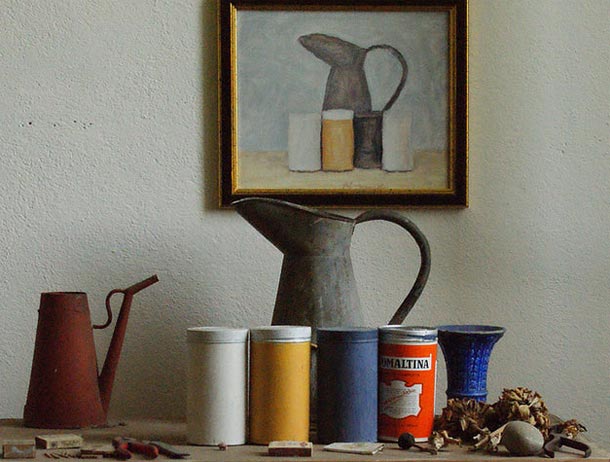
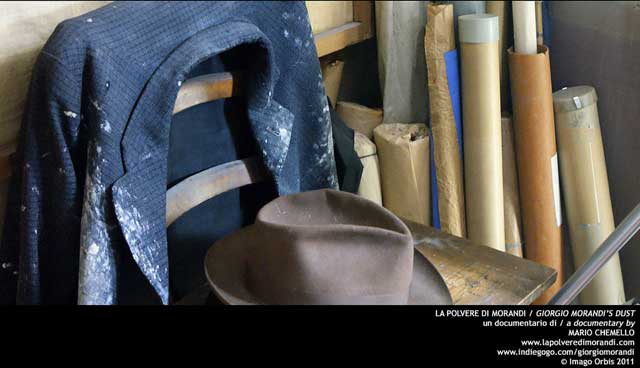
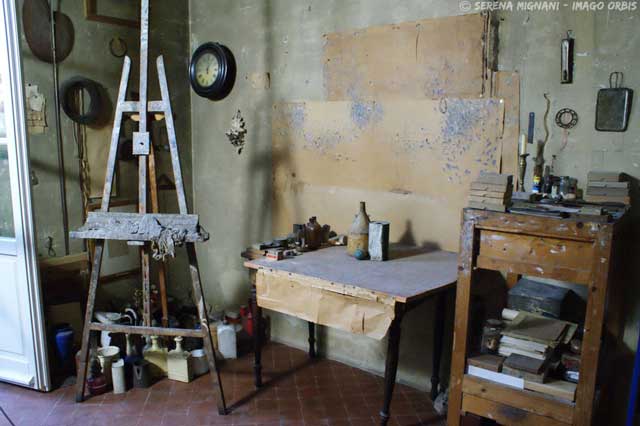
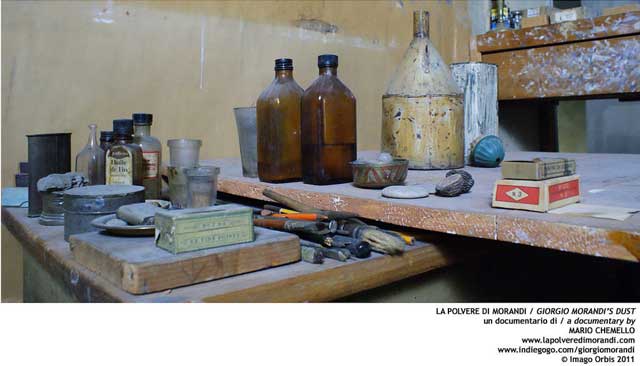
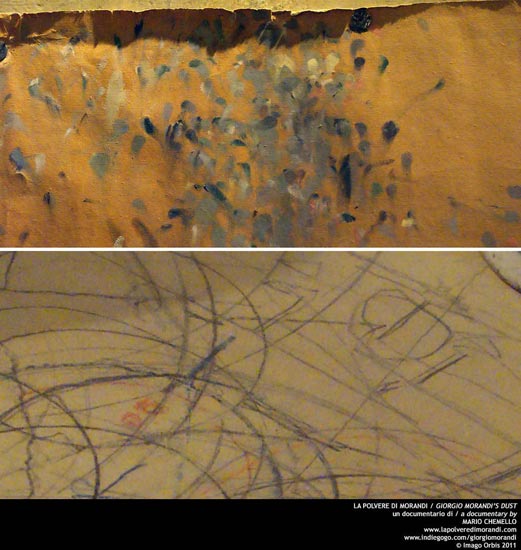




Is this DVD available in US format or only in European format?
good question, I will try to find out. I only watched a special online version but I assume when they reissue the DVD and have it available for sale it should give this information.
I agree that this DVD is well worth ordering, it gives insight into his world, true it does not cover all aspects. I was lucky enough to go to London to see the Morandi exhibition there this past April, I saw the DVD there and ordered it, I live in region 2 so I do not know about the USA which is region 1.
Also till September 2013 there is a fantastic exhibition in Brussels of Morandi, a retrospective at BOZART. I saw it last month and will go see it again. It is well worth the trip, but If you can not get to see it the catalog is excellent.
This exhibition features his landscapes as well as still lifes.
To all those wondering, the Morandi’s Dust dvd is available for order online. Check out all informations here: http://www.lapolveredimorandi.com/eng/giorgio-morandis-dust-documentary-available-on-dvd/
and thanks again Larry for your wonderful work! please get back to us so we can send you a dvd!
Morandi’s association with Fascism is a tricky business. During the late 20’s he demonstrated some enthusiasm for the party which seemed to be progressive and promoting positive change. He exhibited during the 30’s with a group called Strapaese. The fascist party promoted this movement as it celebrated the landscape as well as artists of the past. However during 1943 Morandi was held in jail for a week for demonstrating sympathy for anti-fascists. It is difficult to imagine the artist of Via Fondazza wearing a black shirt and giving the Roman salute.
Ray Ciarrocchi
Your writing is just as beautiful. “This film has the kind of thrills only a painter is likely to appreciate…” I read this paragraph several times and may come back for more!